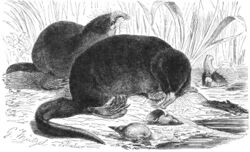Biology:Desman
From HandWiki
Short description: Subfamily of Eurasian insectivores
| Desmanini[1] | |
|---|---|

| |
| Russian desman (Desmana moschata) | |
| Scientific classification | |
| Domain: | Eukaryota |
| Kingdom: | Animalia |
| Phylum: | Chordata |
| Class: | Mammalia |
| Order: | Eulipotyphla |
| Family: | Talpidae |
| Subfamily: | Talpinae |
| Tribe: | Desmanini Thomas, 1912 |
Desmans are diving insectivores of the tribe Desmanini (also considered a subfamily, Desmaninae) in the mole family, Talpidae.
This tribe consists of two extant monotypic genera of semiaquatic insectivores found in Europe: one in Russia and the other in the northwest of the Iberian peninsula and Pyrenees. Both species are endangered, the Russian desman critically so.[2][3] They have webbed paws and their front paws are not well-adapted for digging. Desmans were much more diverse and widespread during the Miocene, with two genera, Gaillardia and Magnatalpa, being present in North America.[4][5] Both living species are thought to have derived from the fossil genus Archaeodesmana.[6]
Species
- Genus Desmana
- Genus Galemys
- Pyrenean desman (G. pyrenaicus)
- Genus †Asthenoscapter Miocene, Europe[7]
- Genus †Archaeodesmana Miocene-Pliocene, Europe
- Genus †Desmanella Miocene, Europe[8][9]
- Genus †Gaillardia Miocene, North America
- Genus †Mygalinia Late Miocene, Hungary
- Genus †Magnatalpa Miocene-Pliocene, North America[5]
- Genus †Ruemkelia[10]
Gallery
In the media
- Morelle, Rebecca (2012-09-04). "Pyrenean desman: On the trail of Europe's weirdest beast". BBC News Online. https://www.bbc.co.uk/news/science-environment-19260705. "video report"
- "Russians rally for water mammal". BBC News Online. 2006-06-09. http://news.bbc.co.uk/1/hi/world/europe/5065428.stm.
References
- ↑ Hutterer, R. (2005). Wilson, D.E.; Reeder, D.M.. eds. Mammal Species of the World: A Taxonomic and Geographic Reference (3rd ed.). Johns Hopkins University Press. p. 303. ISBN 978-0-8018-8221-0. OCLC 62265494. http://www.departments.bucknell.edu/biology/resources/msw3/browse.asp.
- ↑ Quaglietta, L. (2022). "Galemys pyrenaicus". IUCN Red List of Threatened Species 2022: e.T8826A214429993. doi:10.2305/IUCN.UK.2022-1.RLTS.T8826A214429993.en. https://www.iucnredlist.org/species/8826/214429993.
- ↑ Rutovskaya, M.; Gazzard, A.; Turvey, S.T. (2023). "Desmana moschata". IUCN Red List of Threatened Species 2023: e.T6506A231334630. https://www.iucnredlist.org/species/6506/231334630.
- ↑ Martin, James E. (2017). "A rare occurrence of the fossil water mole Gaillardia (Desmanini, Talpidae) from the Neogene in North America". Proceedings of the South Dakota Academy of Science 96: 95–98. https://sdaos.org/wp-content/uploads/pdfs/2017/94-98.pdf.
- ↑ 5.0 5.1 5.2 5.3 5.4 5.5 5.6 Oberg, Danielle; Samuels, Joshua (2022). "Fossil moles from the Gray Fossil Site (Tennessee): Implications for diversification and evolution of North American Talpidae". Palaeontologia Electronica. doi:10.26879/1150.
- ↑ Minwer-Barakat, Raef; García-Alix, Antonio; Martín-Suárez, Elvira; Freudenthal, Matthijs (2020-12-01). "Early Pliocene Desmaninae (Mammalia, Talpidae) from Southern Spain and the Origin of the Genus Desmana" (in en). Journal of Vertebrate Paleontology 40 (5): e1835936. doi:10.1080/02724634.2020.1835936. ISSN 0272-4634. Bibcode: 2020JVPal..40E5936M. https://www.tandfonline.com/doi/full/10.1080/02724634.2020.1835936.
- ↑ Hutchison, John Howard (1974). "Notes on type specimens of European Miocene Talpidae and a tentative classification of old world Tertiary Talpidae (Insectivora: Mammalia)". Geobios 7 (3): 211–256. doi:10.1016/s0016-6995(74)80009-4. Bibcode: 1974Geobi...7..211H.
- ↑ Meier, Patricia; Bickelmann, Constanze; Scheyer, Torsten; Koyabu, Daisuke; Sánchez-Villagra, Marcelo (2013). "Evolution of bone compactness in extant and extinct moles (Talpidae): exploring humeral microstructure in small fossorial mammals". BMC Evolutionary Biology 13: 55. doi:10.1186/1471-2148-13-55. PMID 23442022.
- ↑ "Palaeobiology Database: Desmanella stehlini". https://paleobiodb.org/classic/checkTaxonInfo?taxon_no=65634.
- ↑ Rzebik-Kowalska, Barbara; Pawłowski, Jerzy. "Ruemkelia (Mammalia, Insectivora, Talpidae) nom. nov. for Dibolia RÜMKE, 1985 (nec LATREILLE, 1829)". Acta Zoologica Cracoviensia.
Wikidata ☰ Q940295 entry
 |



